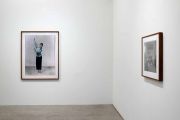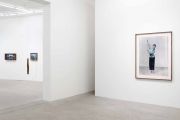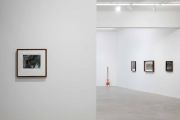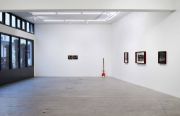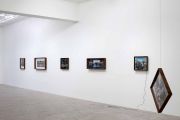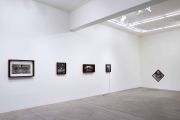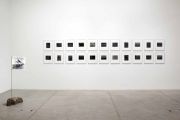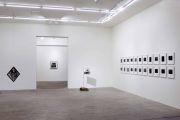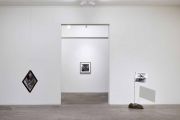Cai Dongdong
A Game of Photos
December 7, 2023 - April 27, 2024
Extended to April 27, 2024
Galerie Urs Meile Lucerne
Press Release - English
Galerie Urs Meile is pleased to announce the first solo exhibition of Chinese artist Cai Dongdong at both of our gallery spaces in Lucerne and Zurich. As an artist who takes photography and installation as his major creative media, re-creating based on ready-made photographs, either taken by himself or collected by him, has always been Cai Dongdong’s main approach. Aiming at the complex cultural aspects behind, he brings “photography” into the intricate, problematic field of the image history or image-making history, discussing issues such as the essence of presentation and the power dynamic of viewing. This exhibition will focus on some of the most iconic photographs and installations from his work series A Game of Photos from recent years.
“I am not interested in the content of the images, which by their very nature are deceptive, but in the hidden mechanisms
behind their production. I try to tear away the veil of hypocrisy by processing these images, even if it only reveals a moment
of truth.”
– Cai Dongdong
Decontruction of the Image
For Cai Dongdong, perhaps his “interest” firstly means the pleasure of deconstruction - deconstructing the original context of the image and the ideological dissemination behind it. In his years of photo experiments, Cai Dongdong has continuously led the secluded historical images to escape from the established references, liberating themselves from the sealed narrative, and rekindling their folded potentials. His approach is also imbued with his characteristic linguistic experimentation and improvisational play. In Fruit Picking, 2022 (silver gelatin print, mirror, watercolor, 64 x 54 cm, edition of 1 + 1 AP), he replaces some of the peaches on the photograph with small mirrors to achieve the effect that “the peaches really look like they have been plucked out of the photograph”. The viewer can see his own reflection in the small lenses; Loggers, 2022 (2/5, Silver gelatin print, watercolor, collage, 50.5 x 58 cm, edition of 5 + 1 AP) comes from an early photograph taken by the artist of a lumberjack who cut down a
tree in the springtime, and it just so happens that the woman from the other film is also sitting on such a tree. The grafting of the two photographs creates a sexual allusion. Miss the Target, 2016 (6/6, silver gelatin print, arrow, 54 x 54 x 86 cm, edition of 6 + 2 AP) is of visually bizarre. The original scene shows the People’s Liberation Army popularizing shooting to the masses, and Cai Dongdong inserted a real arrow into the picture, but intentionally deviated from the bull’s-eye.
Resonance of the History
Cai Dongdong’s works are free from the burden of history, light in technique but serious in gesture. In his creations, the grand narrative of history is descended to an individual perspective, the trajectory of the story quietly distorted by serial disruptions, and the intention of the image organically rearranged by shift enlightenment. The wit and humor are not the only consoling qualities in his works, but also the resonance with the vivid life experience of several generations of people, which conveys a profound
dialectical reflection between the theory of individual existence and the dynamics of the times. On Fire, 2022 (silver gelatin print, watercolor, mirror, 51.5 x 51.5 cm, edition of 1 + 1 AP) comes from a negative collected by the artist. The content is related to the ravaged “Destroy the Four Olds”1 campaign launched in the 1960s, in which families took out their antiques and paintings and burned them in public. Cai Dongdong lit a fire on top of the fire, as if the fire in the picture had set the whole photo ablaze. The
three girls in the negative of Gaze, 2023 (silver gelatin print, collage, 49 x 59 cm (photo); 59.5 x 69 cm (framed), edition of 1 + 1 AP) look forward together, with what seems like hope in their eyes. This style of photograph was popular in China in the 1960s and 1970s, a uniform pose directed by the photographer, emphasizing a hopeful gaze toward the future. It was, in essence, an ideological approach to photography. Cai Dongdong developed many copies of their eyes, then pasted these “gaze” onto the photograph,
creating a multitude of hopeful expression.
The Temperature of Handmade
Using photos as working materials, Cai Dongdong’s own photography soon became depleted. He started his journey to collect vintage Chinese negatives from the past, gathered them from flea markets or yard sale, and brought them back to the darkroom to be re-processed. By manipulating the photographs in various ways - curling, sanding, transplanting, scraping, tearing, burning, etc. - to discover a certain “dramatic structure” behind the rigid images and to give them a new vitality. The labor of the hands
leaves traces on the works, bringing in the temperature and attitude of the human being. Queue Training, 2023 (2/5, archival inkjet print, rope, stone, 90 x 113 cm (framed), edition of 5 + 2 AP) presents a group of girls in military training. The People’s Liberation Army is instructing them to march in perfect manner, which means that everyone’s feet should be lifted to form a line, so the artist followed this logic and added a real red line in front of their feet to the photograph, and then used a stone to drop it down next to the photo to straighten the line. With these actions performed by the artist, the materiality outside the photograph combines with the content of it to form a kind of self-referentiality. Having the Meeting, 2022 (1/3, silver gelatin print, collage, 63.2 x 63.2 cm, edition of 3 + 1 AP), depicts a group of people likely engaged in political study. Behind them on the wall are four portraits - Marx, Engels, Lenin, and Stalin. They are probably studying political theories related to Marxism, with a globe placed on the table,
signifying their intention to promote Marxism globally. Cai Dongdong developed copies of the globe according to the size of their heads, and pasted them on their heads one by one, resulting in a gathering of Earths in a meeting.
Transformation of the Subject of Viewing
Cai Dongdong’s works are gradually unfolded around the subject and relationship of viewing. The implantation of mirrors and camera lenses in his works acts not merely as a superficial visual intervention, but also subverts the unidirectional movement of viewing. The strewn, indiscriminate display injects a whiff of whimsy into this otherwise examination and retracing of history. The photographs, carefully selected and arranged in a playful yet meticulous manner, appear absurd, but these
subtle visual elements often manage to confront the audiences in the most unbiased way. They work to inspire reflections and raise questions on these subjects. Military Exercises, 2022 (2/3, silver gelatin print, watercolor, photographic lens, 37.5 x 75 cm (photo), 61 x 98.5 cm (frame), edition of 3) shows militiamen practicing shooting airplanes. They are carrying rifles and aiming at the sky. Cai Dongdong developed the photo again in reverse, spliced them together, and then put a camera lens in the center, so that the
picture becomes a shot of them shooting at the lens. Eyes, 2020 (1/2 AP, silver gelatin print, photographic lens, 2 pcs., each 27 x 35 x 5.5 cm, edition of 5 + 2 AP) presents a group of ethnic minorities dancing in a circle, and this circle looks like an eye to the artist, so he processed the photo one in original, the other in reverse and achieved a pair of eyes. Lastly, he installed two camera lenses into of the eyes, which became their pupils. When the viewer is watching this work, it seems that these pair of eyes are also watching us, thus creating a rotating relationship between the viewer and the viewed photograph.
Cai Dongdong was born in 1978 in Gansu province, China. He studied at Beijing Film Academy in 2002. Currently, he lives and works in Beijing, China, and Berlin, Germany. In the 2018 Paris Photo, New York Times reported that Cai Dongdong was one of the eight brilliant artists in the field of directing the creative ways of photography in the future. He was awarded “The First Prize of Third Terna Contemporary Art Award” in Italy, and “TOP 20 Young Photographers” in 2015 China Contemporary Photography. His photography book “History of Life” was published in 2021 and “Left Right” in 2022. Cai Dongdong has been presented in various museums and institutions, including Goslarer Museum (2021, Goslarer, Germany); Museum für Fotografie (2017, Berlin, Germany); Eli Klein Gallery (2017, New York, USA); Pully Museum of Art (2017, Switzerland); Taikang Space (2016, Beijing, China); Kunstraum Potsdam (2016, Berlin, Germany); Minsheng Art Museum (2016, Shanghai, China); Hive Center for
Contemporary Art (2015, Beijing, China); Three Shadows Photography Art Center (2015, Beijing, China); CAFA Art Museum (2015, Beijing, China); Echigo-Tsumari Art Triennial (2015, Niigata, Japan); Museum Folkwang (2015, Essen, Germany); Pace Beijing (2014, Beijing, China); He Xiangning Art Museum (2014, Shenzhen, China); Les Amis de Nouvelles D’Europe (2014, Vienna, Austria); Urban Arts Space, the Ohio State University (2014, Ohio, USA); National Art Museum of China (2011, Beijing, China); UNIDEE
Foundation (2011, Turin, Italy); Dong Gang Museum of Photography (2006, Korea); Guangdong Museum of Art (2005, Guangzhou, China), etc.
1 The Four Olds (simplified Chinese: 四旧; pinyin: sì jiù) was a term used during the Cultural Revolution by the Red Guards in the People’s Republic of China in reference to the pre-communist elements of Chinese culture they attempted to destroy. The Four Olds were: Old Ideas, Old Culture, Old Customs, and Old Habits. The campaign began in Beijing on August 19, 1966, shortly after the launch of the Cultural Revolution.
Downloads
Press Release (PDF German)
Opening
Thursday, December 7, 2023, 5.30 - 7.30 pm
Opening Hours
Tuesday - Friday, 10 am - 6 pm, and by appointment
Exhibition Views

